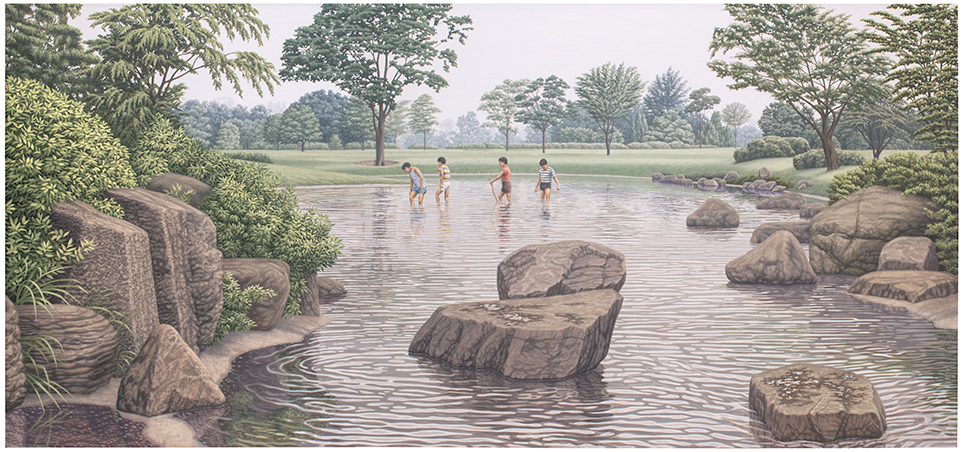
Detail of Quiet Waters
QUIET WATERS: the artist's view
SKU: 1
As seen in Quiet Waters, distance in a landscape (from near to far) is created by gradual changes in color, size and focus.
• Sizes of things get smaller as the distance recedes.
• And colors move from brighter to grayer, from higher contrast to lower contrast.
• And focus goes from clearer to more blurred–so the edges of objects go from sharper to softer.
These simple, basic realities are important tools for me in my art.
Space is a major theme of Quiet Waters. Four levels of space, from front to back, create great depth–and a space that you the viewer are drawn into:
1st. The nearest space on this side of the large, middle rocks, which invites you into the picture–or into the small space in the lower-left corner.
2nd. The space from the large, middle rocks to the boys.
3rd. The space from the boys to the far line of trees.
4th. The farthest space of light, gray-blue trees.
Interestingly, the height of the camera determines the height of the horizon line. And the height of the horizon line determines where the eye of the viewer is–the "height" from which you are looking at the picture.
The rocks are visual stepping stones in the lower three-fifths of the picture. The spaces between them (negative spaces) have a kind of magnetic pull that draws your eye across the gaps between the rocks, tying the picture together. This "magnetic" sense comes from the shapes of the rocks (e.g., the front-middle rock "points" to the rocks on the right), and from them being placed in right relationship with each other. Similarly, the large trees in the top-third work together to hold the negative space of the sky in place. So the trees and rocks are working together to define the big negative space of sky & water that runs down the middle of the picture–as well as pull together the right and left sides of the picture which are spread far apart. The right and left sides are also tied together by the grass "bridge" in the distance.
So arranging space from front to back is not my only compositional goal. I am also arranging the space from top to bottom and left to right–creating a kind of loose "structure" of shapes that is "hung" between the edges of the picture (as described in the previous paragraph). This goal comes from my years making abstract paintings–abstract pictures are typically the arrangement of shapes, lines, colors and textures on the flat surface of the picture.
The two, distant trees, cropped by the top of the picture, are critical in maintaining this surface "structure." Cutting off the tops of the trees keeps the top edge of the picture, and the sky, from zooming off into the far distance. It makes the top edge of the picture, and of the sky, appear to be on the surface of the print. And the tree just left of center is in sharper focus than it logically should be, making it seem a little nearer than it normally would, thus becoming a shape that ties in with the cluster of trees and bushes in the left foreground. The large tree on the right holds the top of the "structure" together by reaching left across the sky toward the center-left tree. So these trees and the rocks combine together to make up the loose "structure" on the surface level of the picture that is critical to the over-all composition–a composition of deep space viewed through this surface "structure."

Detail of Quiet Waters

Title: Quiet Waters Size: 14.7 x 31.6" / 37.4 x 80.2 cm $211 Edition: 299 (Signed/Numbered/Unframed) Date: 2025